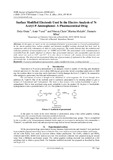| dc.contributor.author | Duke, Orata | |
| dc.contributor.author | Amir, Yusuf | |
| dc.contributor.author | Nineza, Claire | |
| dc.contributor.author | Marina, Mukabi | |
| dc.contributor.author | Damaris, Mbui | |
| dc.date.accessioned | 2014-07-02T09:30:08Z | |
| dc.date.available | 2014-07-02T09:30:08Z | |
| dc.date.issued | 2014 | |
| dc.identifier.citation | 1-Department of Chemistry University of Nairobi Box 30197-00100, Nairobi 2- University of Burundi Bujumbura, Burundi. | en_US |
| dc.identifier.uri | http://hdl.handle.net/11295/71643 | |
| dc.description.abstract | : In this paper we report on the electrochemical behavior of paracetamol or N-acetyl-p-aminophenol.
In the electro-analysis bare carbon graphite and bentonite modified working electrode has been used in
conjunction with cyclic voltammetry to study its redox properties. The results indicate that, the oxidation and
reduction potentials of paracetamol occur at 0.600V and 0.750V. The paracetamol cyclic voltammogram is
reversible.From the results obtained we observe that, paracetamol interacts with consumables such tea and
milk; metal ions such as CO2+
and Fe2+. It is also shown to interact with vitamin, ferrous fumarate and
hydrocortisone. The observed electrochemical behaviour of paracetamol, if replicated at the cellular level, can
give insight into its mechanistic and interactive pathways. | en_US |
| dc.title | Surface Modified Electrode Used In The Electro-analysis Of N-Acetyl P-Aminophenol- A Pharmaceutical Drug | en_US |
| dc.type | Article | en_US |

